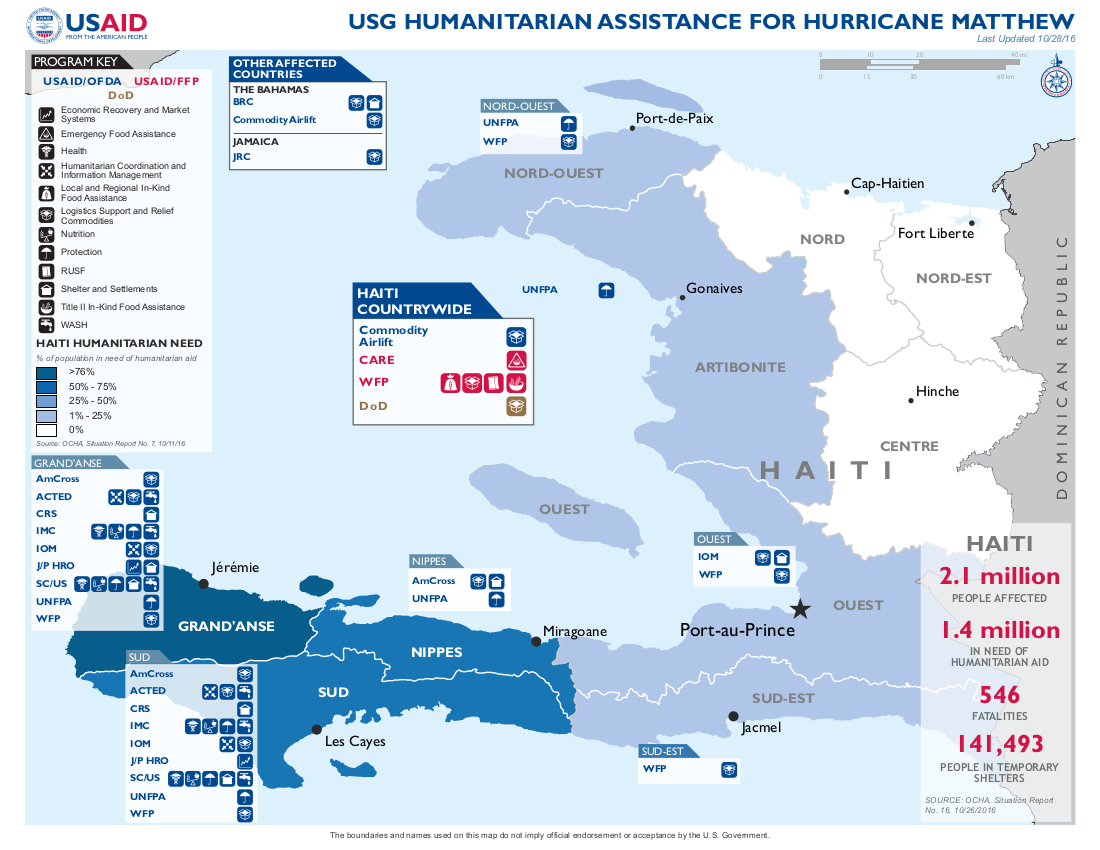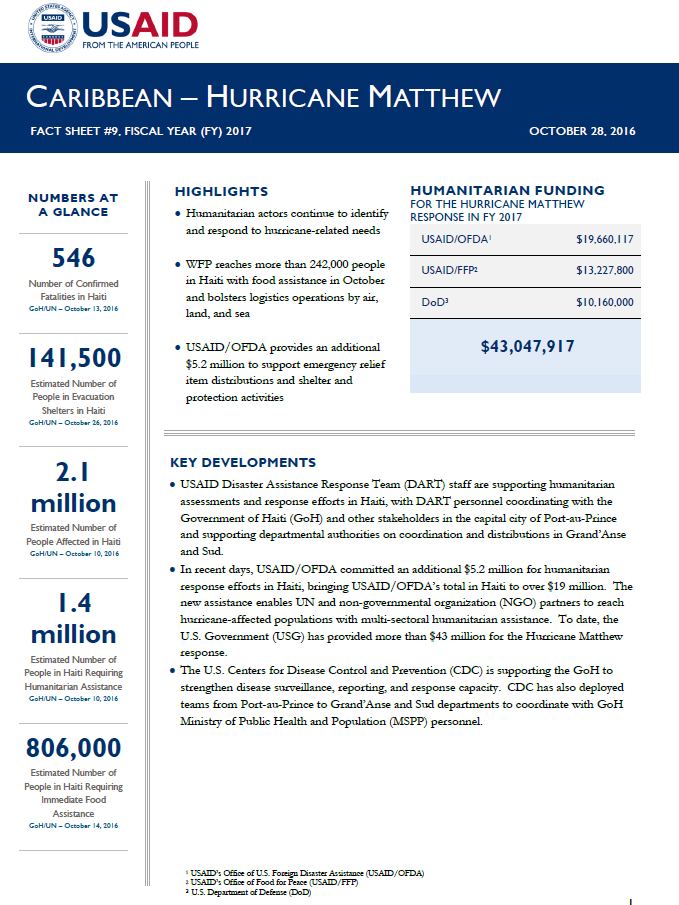October 28, 2016
Highlights
Humanitarian actors continue to identify and respond to hurricane-related needs
WFP reaches more than 242,000 people in Haiti with food assistance in October and bolsters logistics operations by air, land, and sea
USAID/OFDA provides an additional $5.2 million to support emergency relief item distributions and shelter and protection activities
Key Developments
Numbers At A Glance
546
141,500
2.1 million
1.4 million
806,000
Humanitarian Funding
For the Hurricane Matthew Response
in FY 2017
| USAID/OFDA | $19,660,117 |
| USAID/FFP | $13,227,800 |
| DoD | $10,160,000 |
| TOTAL | $43,047,917 |
USAID Disaster Assistance Response Team (DART) staff are supporting humanitarian assessments and response efforts in Haiti, with DART personnel coordinating with the Government of Haiti (GoH) and other stakeholders in the capital city of Port-au-Prince and supporting departmental authorities on coordination and distributions in Grand’Anse and Sud.
In recent days, USAID/OFDA committed an additional $5.2 million for humanitarian response efforts in Haiti, bringing USAID/OFDA’s total in Haiti to over $19 million. The new assistance enables UN and non-governmental organization (NGO) partners to reach hurricane-affected populations with multi-sectoral humanitarian assistance. To date, the U.S. Government (USG) has provided more than $43 million for the Hurricane Matthew response.
The U.S. Centers for Disease Control and Prevention (CDC) is supporting the GoH to strengthen disease surveillance, reporting, and response capacity. CDC has also deployed teams from Port-au-Prince to Grand’Anse and Sud departments to coordinate with GoH Ministry of Public Health and Population (MSPP) personnel.
HUMANITARIAN ACCESS AND LOGISTICS SUPPORT
The UN World Food Program (WFP) reported ongoing road access constraints—including damaged or destroyed bridges and roads impassable by heavy vehicles—in hurricane-affected areas, particularly along the western coasts of Grand’Anse and Sud, as of October 26. However, reports from humanitarian actors indicate that access has continued to improve over time.
The Logistics Working Group—the coordinating body for humanitarian logistics activities in Haiti, comprising UN agencies, NGOs, and other stakeholders—is utilizing WFP assets to transport relief personnel and cargo. As of October 26, the working group had coordinated the air transport of 220 passengers and 14 metric tons (MT) of cargo for 17 humanitarian organizations to hurricane-affected areas, according to the UN. In addition, the Logistics Working Group is supporting humanitarian to bring food and emergency relief commodities to vulnerable populations in coastal areas via sea transport, with two vessels with a capacity of 110 MT transporting cargo from Port-au-Prince to ports in Grand’Anse and Sud.
FOOD ASSISTANCE
The UN estimates that 806,000 people require food assistance due to Hurricane Matthew’s impacts. WFP—initially appealing for $46 million to address humanitarian food needs—had raised its appeal to $48 million as of October 26, according to the UN.
Between October 8–25, WFP reached 242,000 people in Grand’Anse, Nippes, and Sud with 1,930 MT of food. In the same time period.
Three NGOs are distributing WFP food assistance in eight communes of Grand’Anse. Samaritan’s Purse is conducting distributions in Abricots, Bonbon, and Moron communes; the Agency for Technical Cooperation and Development (ACTED) is covering Anse d’Hainault, Dame Marie, and Les Irois communes; and Italian NGO Cesvi is distributing food in Corail and Pestel communes. Additionally, ACTED, the International Organization for Migration (IOM), and WFP are conducting joint distributions in Grand’Anse’s Jeremie commune. WFP is increasing logistical capacity at the Jeremie hub to support the accelerating pace and scope of food distributions in Grand’Anse.
HEALTH AND WASH
USAID/OFDA is supporting NGO partners ACTED and International Medical Corps (IMC) to implement activities—such as improving access to essential WASH services, distributing hygiene and WASH kits, and establishing oral rehydration sites—that address urgent health and WASH needs in Grand’Anse and Sud.
In coordination with the MSPP, CDC continues to monitor health issues and bolster surveillance capacity in hurricane-affected communities. On October 25 and 26, CDC deployed six staff from Port-au-Prince to support response activities in hurricane-affected areas, including bolstering cholera surveillance, investigating diarrheal disease reports, and improving case management systems of diarrheal syndromes—including cholera.
The GoH plans to launch an oral cholera vaccination campaign in early November, targeting populations in nine of Sud’s communes and five of Grand’Anse’s communes. On October 25, the Pan American Health Organization (PAHO), in coordination with the UN World Health Organization (WHO), reported receiving 500,000 doses of oral cholera vaccine for the upcoming campaign; an additional 500,000 doses are planned to arrive in the coming days. PAHO and WHO have also deployed a water, sanitation, and hygiene (WASH) logistician to support the vaccination campaign.
SHELTER AND RELIEF ITEMS
Approximately 141,500 people continued to reside in 204 temporary shelters in hurricane-affected areas of Haiti as of October 26, the UN reports.
The DART recently procured 32 chainsaws and fuel and transported the equipment to the National Emergency Operations Center, for onward delivery to the Central, Grand’Anse, Nippes, and Sud-Est departmental emergency operational centers (COUDs). The COUDs plan to use the chainsaws for debris removal.
During an assessment trip through rural and urban areas of Jeremie and Moron communes, the DART observed community-led shelter repairs underway in all areas, with many people utilizing USAID/OFDA-supplied plastic sheeting. USAID/OFDA recently committed an additional $300,000 to partner J/P Haitian Relief Organization (J/P HRO) to provide emergency shelter kits, as well as training and supervision on the use of kit materials, for 4,100 hurricane-affected households—approximately 20,500 people—with badly damaged or destroyed houses in Grand’Anse.
USAID/OFDA awarded the American Red Cross (AmCross) with more than $1.2 million to provide emergency relief items—such as blankets, hygiene kits, and kitchen sets—to approximately 90,000 people and to deliver emergency shelter material to an estimated 10,000 people in Nippes. USAID/OFDA also provided AmCross with $150,000 immediately following the hurricane to reach affected populations with relief commodities in Grand’Anse and Sud.
With $500,000 in new USAID/OFDA funding, IOM is responding to the emergency shelter needs of 70,000 people in Ouest. IOM activities include proving materials to rehabilitate damaged houses and emergency shelter structures throughout hurricane-affected communities in the department.
PROTECTION
Populations in hurricane-affected areas of Haiti are vulnerable to sexual and gender-based violence (SGBV), family separation, exploitation and abuse, according to the UN. The Haiti Flash Appeal—launched by the UN Office for the Coordination of Humanitarian Affairs (OCHA) in coordination with the GoH on October 10—requests $7.2 million for protection interventions, including activities that respond to psychosocial needs, provide child protection services, address SGBV, and ensure that vulnerable people have equal access to humanitarian assistance.
USAID/OFDA recently committed approximately $3 million to Save the Children/U.S. (SC/US) and the UN Population Fund (UNFPA). SC/US is working in Grand’Anse and Sud to address multi-sectoral humanitarian needs, including protection needs; with USAID/OFDA funding, the NGO is providing information on protection needs and available services for children, facilitating the creation of child-friendly spaces at temporary shelter sites, and supporting recreational activities for children impacted by Hurricane Matthew.
UNFPA is facilitating coordination among SGBV response actors, training local NGOs and community members to establish community watch groups, and supporting protection stakeholders to identify and respond to protection needs among vulnerable women, children, and adolescents in Grand’Anse, Nippes, Nord-Ouest, and Sud.
CONTEXT
Hurricane Matthew made initial landfall near Haiti’s Les Anglais commune, Sud, and secondary landfall over eastern Cuba on October 4 before continuing to traverse The Bahamas from October 5–7. The hurricane brought destructive winds, heavy rainfall, and dangerous storm surge, resulting in extensive damage to crops, houses, and infrastructure, as well as widespread flooding in some areas.
On October 2, U.S. Ambassador to Haiti Peter F. Mulrean and U.S. Chargé d’Affaires, a.i., for Jamaica Eric Khant issued disaster declarations in response to the anticipated effects of Hurricane Matthew. U.S. Chargé d’Affaires, a.i., Lisa A. Johnson issued a disaster declaration in response to the anticipated effects of Hurricane Matthew in The Bahamas on October 4.
USAID activated a regional DART on October 3 with staff in The Bahamas, Haiti, and Jamaica. USAID also stood up a Washington, D.C.-based Response Management Team to coordinate the regional humanitarian response.
Based on assessment findings and in consultation with government representatives in the two countries, USAID discontinued DART operations in Jamaica and The Bahamas on October 5 and 13, respectively. USAID/OFDA regional staff will continue to monitor USAID/OFDA assistance provided to the Bahamas Red Cross (BRC) and the Jamaica Red Cross (JRC) to address the immediate needs of populations affected by Hurricane Matthew.









Comment
Make a general inquiry or suggest an improvement.